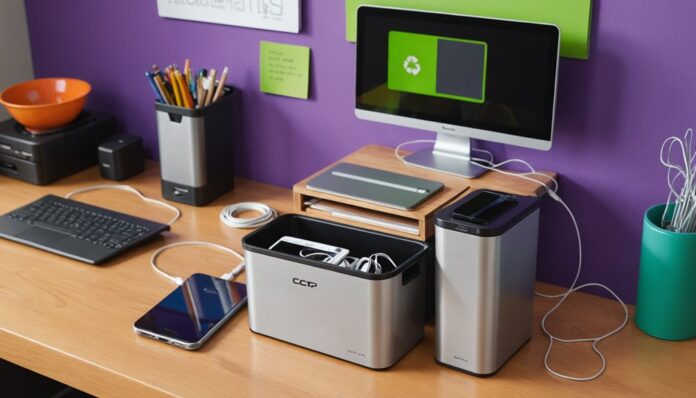Safely recycling old electronics requires attention to detail. Devices must be properly cleaned and prepared to prevent damage and guarantee responsible disposal. With the constant evolution of technology, electronic waste continues to accumulate, posing environmental and health concerns. Identifying and preparing devices for recycling is the first step. To proceed, it is crucial to understand the specific requirements and regulations surrounding electronics recycling.
Highlights
- Identify accepted devices for recycling, including computers, televisions, mobile phones, and printers, and other items like keyboards and mice.
- Prepare electronics by cleaning devices, removing batteries, and detaching external cords, cables, or accessories for safe processing.
- Find local electronics recycling facilities, retailers, or manufacturers with take-back programs, and confirm accepted materials and hours.
- Consider donating still-functional electronics to charity organizations, shelters, or those in need to support bridging the digital divide.
- Ensure data destruction and security measures, such as secure wiping, physical destruction, or degaussing, to protect confidential information.
Identifying Electronic Devices to Recycle
Before attempting to recycle old electronics, individuals must first identify the types of devices that can be recycled. This step is vital in ensuring that the electronics are properly handled and processed at designated recycling facilities.
Electronic devices such as computers, televisions, mobile phones, and printers are commonly accepted for recycling. Individuals can also contemplate recycling other electronic items like keyboards, mice, and speakers.
When identifying devices to recycle, it is essential to evaluate recycling options such as manufacturer take-back programs, local drop-off locations, and community collection events. Researching these options will help individuals determine the best course of action for their electronic waste.
Proper disposal of electronic devices helps to conserve natural resources and mitigate environmental harm.
How to Prepare Electronics for Recycling
Once individuals have identified the electronic devices to be recycled, the next step is to prepare them for safe and efficient processing. This involves cleaning devices to remove dirt, dust, and other contaminants that may interfere with the recycling process. A soft cloth and mild cleaning solution can be used to wipe down surfaces.
Additionally, individuals should focus on removing batteries, as they can be hazardous if not handled properly. It is also important to remove any external cords, cables, or accessories.
Finding an Electronics Recycling Facility Near You
Where can individuals take their prepared electronics for safe and responsible recycling?
The next step is to locate an electronics recycling facility nearby. Many communities have designated electronics recycling centers or facilities that accept prepared electronics.
To find a local recycling center, individuals can search online or check their local government website for options. Some retailers and manufacturers also offer take-back programs or drop-off locations for electronics recycling.
It is important to call ahead to confirm the facility hours and accepted materials before visiting. Additionally, some communities may have special collection events for electronics and other household hazardous waste.
Donating Still-Functional Electronics
Not all electronics destined for disposal are obsolete or non-functional. Many devices can still be used and appreciated by those in need.
Donating still-functional electronics is a viable alternative to recycling, allowing individuals to give back to their community while also reducing electronic waste. Charity organizations accept a wide range of electronics, including computers, phones, and tablets.
Local shelters, in particular, benefit from donations of working electronics, which can be used by residents to access essential services, stay connected with loved ones, and pursue educational and employment opportunities.
Donating electronics can make a significant difference in the lives of those who receive them, providing a sense of connection and belonging. By donating, individuals can help bridge the digital divide and support those in need.
Data Destruction and Security Measures
Properly destroying sensitive data is a crucial step in the electronics recycling process, as it prevents unauthorized individuals from accessing confidential information.
Data protection is a critical concern for individuals, businesses, and organizations, as breaches can lead to severe consequences.
To guarantee data security, electronic devices must undergo secure wiping, which involves completely erasing all data stored on the device. This process can be done through various methods, including physical destruction, degaussing, and logical wiping.
Electronics recycling facilities often use specialized software to perform secure wiping, assuring that all data is completely and irretrievably erased.
Understanding Electronics Recycling Certifications
Electronics recycling facilities that prioritize data security often obtain certifications to demonstrate compliance with industry standards.
These certifications confirm that the facility adheres to rigorous protocols for securely handling and destroying sensitive data. The most common certifications include R2 (Responsible Recycling) and e-Stewards.
R2 is a widely recognized certification standard that emphasizes responsible recycling practices, while e-Stewards is a certification that focuses on socially and environmentally responsible e-waste management.
Both certifications have strict requirements for recycling processes, ensuring that electronics are dismantled and recycled in a way that protects data and minimizes environmental harm.
Creating a Sustainable Electronics Recycling Habit
As consumers continually upgrade to newer devices, developing a consistent approach to electronics recycling is essential for mitigating the environmental impacts of e-waste.
By incorporating sustainable practices into daily life, individuals can meaningfully reduce their ecological footprint. One effective way to create a sustainable electronics recycling habit is to establish a routine of regularly sorting and collecting used devices. This can be achieved by designating a specific area for storing old electronics and scheduling regular drop-offs at certified recycling centers.
Additionally, consumers can investigate eco-friendly solutions, such as purchasing refurbished devices, buying products with minimal packaging, and supporting manufacturers that prioritize environmental sustainability.
Conclusion
Proper electronics recycling requires attention to detail and adherence to guidelines. By following the steps outlined, individuals can guarantee responsible disposal of hazardous waste while contributing to a more sustainable future. Donating functional devices can also help bridge the digital divide. By adopting environmentally conscious habits and supporting certified recycling facilities, we can mitigate the environmental impact of electronic waste and promote a healthier planet for future generations.


